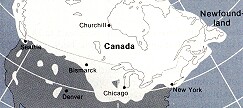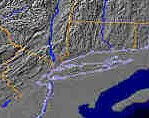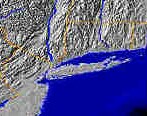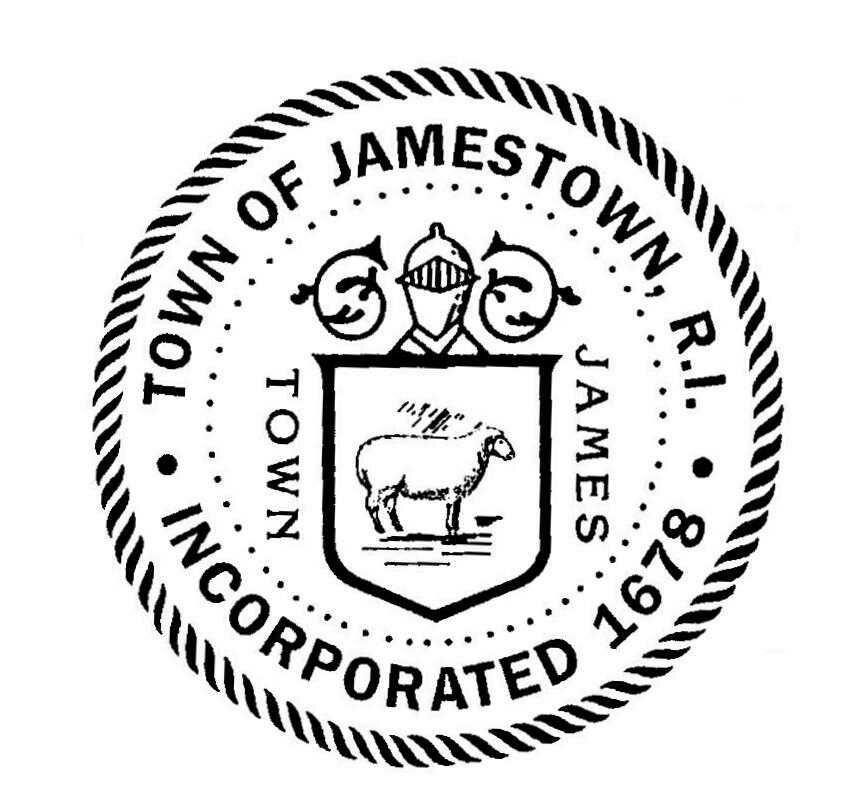In
the Beginning
Before
Humans Arrived, there was the Land and the Water
Many
characteristics of Jamestown and
the entire Narragansett region are traceable to
the geological processes that formed the area. The events
that had the greatest impact on the land was the
coming of the glacial ice of the Pleistocene
Epoch, which started about two million years
ago.
At least four great
glacial advances occured in North America
during the Pleistocene.The final and most
severe stage reached its maximum about
18,000 years ago.
Those glaciers advanced to just south of
New York City and tens of miles beyond
the present coast of Rhode Island - to
the edge of the continental shelf. .
|
 |
As the glaciers
pushed southward, the slowly flowing ice crushed
layers of rocks, ground the surface and carved
channels into the earth. Two of the glacial cuts have
become the East and West Passages which separate Conanicut Island
from the western mainland and from Aquidneck
Island (Newport).
Once warming began the glaciers
retreated fairly rapidly. Rhode Island became
glacier-free about 15,000 years ago. The
retreating glaciers left terminal moraines
(deposits of rocks and other material pushed
southward as the glacier advanced) and other
deposits of soil and rocks from northern New
England.
| Since Rhode Island
glaciers melted before those located
further north, a significant amount of
the world’s water was still frozen
when the area became ice-free. As a
result, sea level was about 150
feet lower than it is today and the area was many miles from the sea (as
shown on the right). The glacial cuts
that would become the East and West
Passages were shallow valleys with
streams and rivers. |
 |
Arrival
of Native Americans
The first humans probably
appeared in the area about 10,000 to 12,000 years
ago. They undoubtedly spent most of their time
close to ancient streams and rivers.
As more northern
ice sheets melted, the sea level rose and
salt water eventually flowed into and
filled the lowest-lying areas, creating
Narragansett Bay. The rising sea level
not only changed the landscape, it forced
animals and people to move to higher
elevations and it submerged most traces
of the earliest inhabitants. The oldest
human artifacts that have been found on Conanicut
Island date from around
3000 BC.
|
 |
By 1300 BC Jamestown
was home (at least a seasonal basis) to many
Native Americans. The largest Indian cemetery in
New England is located on the island; and
artifacts spanning a three-thousand year period
have been recovered from the site (near West
Ferry). Early European explorers and settlers
reported several thousand Wampanoag
and Narragansett Indians
living in the Narragansett Bay area.
European
Settlement
In 1524, the Italian
navigator Giovani Verrazzano became the first
European conclusively known to visit Narragensett
Bay. He did not stay in the area for long, as he
was on a journey of exploration, not settlement.
In 1636 or 1637,
Dutch fur traders purchased the island of
Quentenis and used it as a base for their
activities. This island, located just west of
Conanicut, is now known as Dutch Island and is
part of Jamestown.
In 1638 the English made
arrangements to use Conanicut Island
for grazing sheep. One of the Narragansett
sachems who gave consent was Canonicus. (As a
result of these events, the name
"Conanicut" was given to the island and
the figure of a sheep is in a central position in
the Jamestown seal.)
In 1657 a consortium of about one
hundred buyers purchased Conanicut,
Dutch and Gould Islands. They divided Conanicut
Island into roughly one dozen large
plots and reserved Dutch Island and parts of Conanicut
Island for common use. Benedict Arnold,
one of the purchasers, became governor of the
colony of Rhode Island the same year. He returned
to the office several times - in 1662, 1663, 1669
and 1677.
The Native Americans and newly arrived
colonists lived
side-by-side in relative peace for almost four
decades. Unfortunately, conflicts eventually
occured in a number of places in southern New
England, leading to what is known as King
Philip's War. Although Conanicut Island
remained a haven for many Native Americans, after
1676, life in the region was dominated by the
colonists.
Ferries
were in operation between Conanicut
Island and Newport
by 1675.
In 1678, Jamestown
was incorporated. The town's name honored
Prince James, later King James II. It had
about 150 residents.
By 1700, the
agriculturally-prosperous town had about
200 residents.
|
 |
* * * * * * * * * * * * * * * *
* * * * * * * * * * * * * * * * * * * * * * * * *
* * * * * * * * * * * * *
Click the
following link for the next installment of this
history narrative
The Eighteenth Century
Growth
as a Colony - The War for Independence
- After Independence
* * * * * * *
* * * * * * * * * * * * * * * * * * * * * * * * *
* * * * * * * * * * * * * * * * * * * * * *
Or go directly to other portions
of the narrative:
* * * * * * * * * * * * * * * *
* * * * * * * * * * * * * * * * * * * * * * * * *
* * * * * * * * * * * * *
Jamestown
RI - Rhode Island Visitor Information Home Page
Direct
questions and comments on this site to Webmaster
|